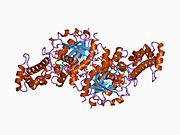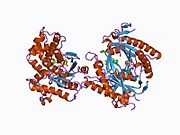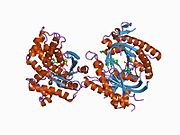GNAS complex locus
| View/Edit Human | View/Edit Mouse |
GNAS complex locus is a gene locus in humans. Its main product is the
Gene
This gene
Products and functions
The GNAS locus is imprinted and encodes 5 main transcripts:
- Gs-α (Gs-α long, P63092-1), biallelic
- A/B transcript (Gs-α short, P63092-2), biallelic: contains an alternate 5' terminal exon (A/B or Exon 1A) and uses a downstream start codon to have a shortened amino terminal region.
- STX16 deletion causes loss of methylation at the A/B exon, leading to PHP1B.
- XLαs (Extra long alpha-s, Q5JWF2), paternal
- ALEX (Alternative gene product encoded by XL-exon, P84996), may inhibit XLαs
- NESP55 (Neuroendocrine secretory protein 55, O95467), maternal
- antisense GNAS transcript (Nespas: neuroendocrine secretory protein antisense)
Alternative splicing of downstream exons is also observed, which results in different forms of the Gs-α, a key element of the classical signal transduction pathway linking receptor-ligand interactions with the activation of adenylyl cyclase and a variety of cellular responses. Multiple transcript variants have been found for this gene, but the full-length nature and/or biological validity of some variants have not been determined.
Three of the GNAS gene products, Gsα-long, Gsα-short, and XLαs, are different forms of Gsα, and differ mainly in the N-terminal region. Traditional G protein-coupled receptor signaling proceeds primarily through Gsα-long and Gsα-short, the most abundant, ubiquitously-expressed protein products of this gene. XLαs is the "extra large" isoform, and has a very long N-terminal region with some internal repeats not well-conserved across species. The XL exon also encodes in another reading frame the protein product ALEX, an inhibitory cofactor binding to the unique domain.[10][7] The structure for GNAS is solved for the canonical P63092-1 isoform only, and little is known about what the special region of XLas or ALEX looks like.
NESP55 is a protein product completely unrelated to the GNAS protein. It undergoes extensive posttranslation processing, and is sometimes grouped as a granin.[11] Nearly nothing is known about its structure; protein structure prediction predicts a mostly disordered protein with an N-terminal globular domain made up of alpha-helices.[12][13]
Clinical significance
Mutations in GNAS products are associated with:
- Albright hereditary osteodystrophy
- pseudohypoparathyroidism type Ia and Ib
- pseudopseudohypoparathyroidism
- McCune–Albright syndrome
- Myxoma[14]
Mutations in this gene also result in
Many alleles in mice have been constructed for analyzing disease associations. Mice with this gene half knocked-out and half-mutated (tm1Jop/Oedsml) display
Interactions
Gsα has been shown to
References
- ^ a b c GRCh38: Ensembl release 89: ENSG00000087460 – Ensembl, May 2017
- ^ a b c GRCm38: Ensembl release 89: ENSMUSG00000027523 – Ensembl, May 2017
- ^ "Human PubMed Reference:". National Center for Biotechnology Information, U.S. National Library of Medicine.
- ^ "Mouse PubMed Reference:". National Center for Biotechnology Information, U.S. National Library of Medicine.
- ^ "Symbol report for GNAS". HUGO Gene Nomenclature Committee.
- PMID 11447126.
- ^ PMID 15148396.
- PMID 21172659.
- ^ "Nespas". Long non-coding RNA db. Archived from the original on 18 June 2017. Retrieved 3 May 2019.
- ^ PMID 12719376.
- PMID 21862681.
- ^ Jianwei Zhu, Sheng Wang, Dongbo Bu, Jinbo Xu. "Result for NESP55". RaptorX. Archived from the original on 4 May 2019. Retrieved 4 May 2019. Compare outputs
- ^ "O95467". MobiDB. Retrieved 4 May 2019.
- PMID 19287459.
- ^ "Entrez Gene: GNAS GNAS complex locus".
- S2CID 34153703.
- ^ "Gnas - GNAS (guanine nucleotide binding protein, alpha stimulating) complex locus". International Mouse Phenotyping Consortium. Retrieved 3 May 2019.
- ^ "Gnas Phenotype Annotations". Mouse Genome Informatics.
- ^ "Gnas Chemically induced Allele Detail MGI Mouse (MGI:2183318)". Mouse Genome Informatics. Retrieved 3 May 2019.
- ^ "Nespas Phenotype Annotations". Mouse Genome Informatics.
- PMID 11264454.
- S2CID 84975473.
Further reading
- Tinschert S, Gerl H, Gewies A, Jung HP, Nürnberg P (March 1999). "McCune-Albright syndrome: clinical and molecular evidence of mosaicism in an unusual giant patient". American Journal of Medical Genetics. 83 (2): 100–8. PMID 10190480.
- Faivre L, Nivelon-Chevallier A, Kottler ML, Robinet C, Khau Van Kien P, Lorcerie B, Munnich A, Maroteaux P, Cormier-Daire V, LeMerrer M (March 2001). "Mazabraud syndrome in two patients: clinical overlap with McCune-Albright syndrome". American Journal of Medical Genetics. 99 (2): 132–6. PMID 11241472.
- Raymond JR, Mukhin YV, Gelasco A, Turner J, Collinsworth G, Gettys TW, Grewal JS, Garnovskaya MN (2002). "Multiplicity of mechanisms of serotonin receptor signal transduction". Pharmacology & Therapeutics. 92 (2–3): 179–212. PMID 11916537.
- Weinstein LS, Chen M, Liu J (June 2002). "Gs(alpha) mutations and imprinting defects in human disease". Annals of the New York Academy of Sciences. 968 (1): 173–97. S2CID 85149630.
- Bastepe M, Jüppner H (2005). "GNAS locus and pseudohypoparathyroidism". Hormone Research. 63 (2): 65–74. PMID 15711092.
- de Sanctis L, Delmastro L, Russo MC, Matarazzo P, Lala R, de Sanctis C (May 2006). "Genetics of McCune-Albright syndrome". Journal of Pediatric Endocrinology & Metabolism. 19 (Suppl 2): 577–82. S2CID 33555734.
- Aldred MA (May 2006). "Genetics of pseudohypoparathyroidism types Ia and Ic". Journal of Pediatric Endocrinology & Metabolism. 19 (Suppl 2): 635–40. S2CID 26538688.
- Jüppner H, Bastepe M (May 2006). "Different mutations within or upstream of the GNAS locus cause distinct forms of pseudohypoparathyroidism". Journal of Pediatric Endocrinology & Metabolism. 19 (Suppl 2): 641–6. S2CID 34302323.
- Mantovani G, Spada A (December 2006). "Mutations in the Gs alpha gene causing hormone resistance". Best Practice & Research. Clinical Endocrinology & Metabolism. 20 (4): 501–13. PMID 17161328.
External links
- GNAS+protein,+human at the U.S. National Library of Medicine Medical Subject Headings (MeSH)
- WikiGene index for literature mentioning this gene:












